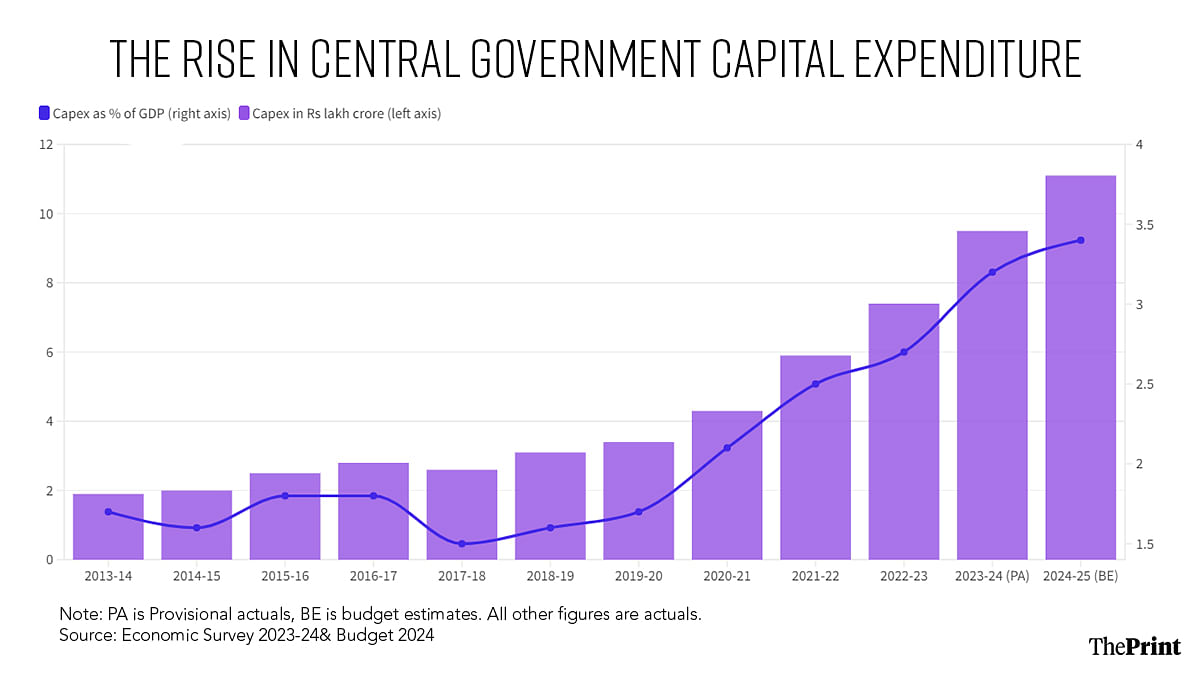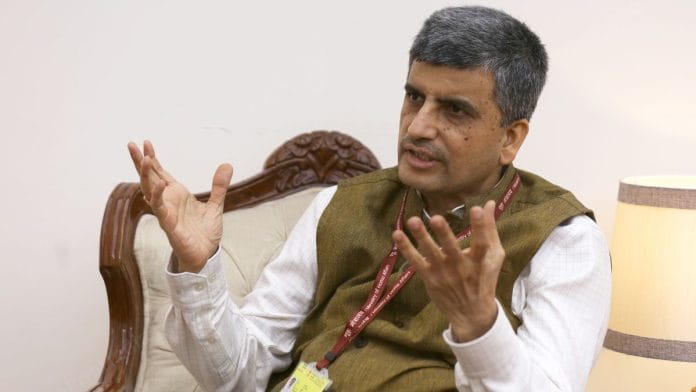New Delhi: The government is unlikely to increase its capital expenditure (capex) spending from the current 3.4 percent of gross domestic product (GDP), with the onus of raising the total capex now falling on state governments and the private sector.
In an interview to ThePrint, Economic Affairs Secretary Ajay Seth said that the level of central government capex as a share of GDP has now reached a “desired level”, adding that the state governments now need to increase their capital expenditure and improve the quality of such spending.
Over and above this, the private sector needs to step in and increase its investments in areas like logistics, warehousing, container services, and multimodal parks, which are “amenable for the private sector to come in”.
Union Budget 2024, the full version of which was announced by Finance Minister Nirmala Sitharaman Tuesday, allocated Rs 11.11 lakh crore for capex, which works out to 3.4 percent of GDP.
This is the same allocation as was made in the interim budget announced in February this year.

“If you look at the Rs 11.11 lakh crore allocation for capex, it is a 11 percent increase over the budget estimate of last year, but about 17 to 18 percent increase over the amount that was actually spent that year,” Seth explained.
“So this has grown much faster than the growth in nominal GDP. The present level of capex has reached a level which is desired, and a strong one,” he added. “This is not something that can keep on increasing.”
Over the previous three years, he explained, the government has increased the share of its capital expenditure from 1.5 percent of GDP to the current 3.4 percent.
“This budget said we will try to maintain a strong support for infrastructure along with other priorities like skilling and education, among others, with fiscal consolidation,” Seth said. “This means that once we have reached a desired level (of capex), other factors come into play. So, it is not as if we can say capex will increase by 30 percent year after year.”
Also read: Hostels, creches, skilling programmes — budget bats for higher participation of women in workforce
State govts must step up capex
The Economic Survey 2023-24, presented in Parliament Monday, laid the onus of taking the next steps to spur capital creation, economic growth, job creation, and improved productivity on the state governments and the private sector, an assessment Seth largely agreed with.
“The state governments’ capex is normally to the order of 2.5 percent of GDP,” Seth said.
“They have space to nudge it to about 3 percent and improve the quality of where they spend their capex.”
Sitharaman had, in her budget speech, said that the 50-year interest-free loans the central government has been providing states for infrastructure investment would also be raised from the previous Rs 1.3 lakh crore. “We will encourage states to provide support of similar scale for infrastructure, subject to their development priorities,” she had said.
Adding, “A provision of Rs 1.5 lakh crore for long-term interest-free loans has been made this year also to support the states in their resource allocation.”
‘Sectors amenable for private sector investment’
Seth explained that the third pillar of the infrastructure push in India was the private sector, and the focus for the government here was on how to encourage companies to invest.
“Not all infrastructure will attract private capital, but there are several areas that will,” he explained.
While the private sector is highly unlikely to start constructing railway lines, because the sole operator on these lines is the Indian Railways, the situation in the roads sector has become more balanced, Seth noted.
“When it comes to roads, in the last one year, the ministry of road transport and NHAI (National Highways Authority of India) have tried to take on a much larger number of public-private partnership projects,” he explained. “In the road sector, balancing the proportion of public and private investment is much more possible.”
“But when it comes to logistics chains to be set up, or warehousing, container services, and multimodal parks to be set up, those are the ones that are amenable for the private sector to come in,” Seth said.
(Edited by Radifah Kabir)
Also read: 6 govt-run banks with public shareholding below 25% likely to hit the market in ‘next few months’






